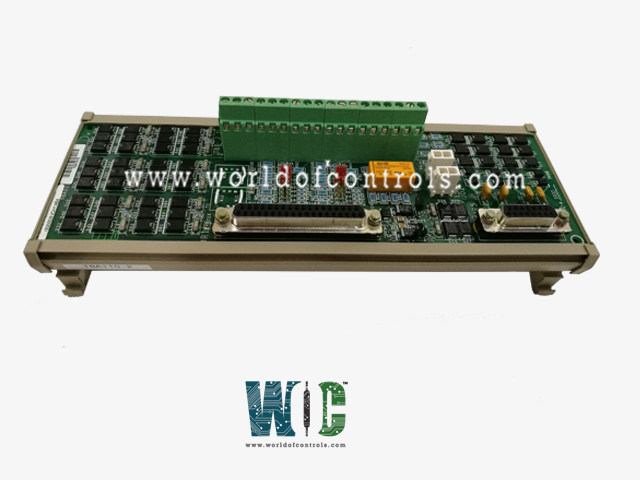SPECIFICATIONS
Part Number: IS200DSVOH2B
Manufacturer: General Electric
Function: Servo Terminal Board
Size: 23.8 cm high x 8.6 cm wide
LVDT excitation outputs: 4
Excitation for pulse rate probes: No
Class 1, Div. 2 certification: Yes
Series: Mark VI
Availability: In Stock
Country of Manufacture: United States (USA)
Functional Description
IS200DSVOH2B is a Servo Terminal Board developed by GE. The DSVO board stands as a compact servo terminal board specifically engineered for easy DIN-rail mounting. Within its design, this board encompasses an array of functionalities: two servo outputs, provisions for six LVDT position sensors, and integration for two active pulse rate inputs crucial for flow measurement. Notably, the board facilitates jumper selection for servo coil currents ranging from 10 to 120 mA, adapting to various operational needs.
Features
Inputs
- LVDT Windings (Linear Variable Differential Transformers): Supports up to 6 LVDT windings, providing precise measurement and feedback for position sensing applications. These windings detect linear displacement with high accuracy, contributing to the system's feedback control mechanism.
- Pulse Rate Signals: It facilitates the handling of 2 pulse rate signals, crucial for measuring and monitoring flow rates within the system. These signals play a pivotal role in flow measurement and control applications, ensuring accurate data acquisition.
- External Trip Signal: Accommodates an external trip signal, which could serve various purposes such as triggering specific actions or emergency shutdown protocols based on external events or conditions.
Outputs
- Servo Valves: Governs 2 servo valves, controlling fluid flow or pressure within the system. These valves regulate the flow of hydraulic or pneumatic fluids to precisely adjust mechanisms or processes.
- Excitation Sources: LVDTs- The board provides 2 dedicated excitation sources for LVDTs, ensuring proper and consistent voltage or current supply to these sensors for accurate measurements. Pulse Rate Transducers- Similarly, 2 dedicated excitation sources are allocated for the pulse rate transducers, maintaining their operational integrity for precise pulse rate measurement.
Fault Detection
Equipped with a robust fault detection system aimed at identifying potential issues that could compromise system functionality or accuracy. It monitors various parameters and conditions, including:
- Servo Current Out of Limits or Unresponsive: The board continuously monitors servo currents, promptly detecting if they exceed predefined limits or fail to respond as expected. This ensures the proper functioning of the servo valves crucial for system control.
- LVDT Excitation Out of Range: It monitors and flags any deviations in the excitation sources for LVDTs, promptly identifying if the supplied voltage or current falls outside the acceptable range required for accurate LVDT measurements.
- LVDT Feedback Out of Limits: Vigilantly checks the feedback signals from LVDTs, quickly recognizing any discrepancies or signals that fall beyond the acceptable limits, ensuring precise position sensing.
- Failed ID Chip: The system incorporates checks for the ID chips embedded on the board. Detection of a failed or malfunctioning ID chip triggers a diagnostic response, allowing swift identification and remediation of the affected board, ensuring system integrity and reliability.
Product Attributes
- Board establishes a connection with the VSVO processor board using a 37-pin cable, sharing identical specifications with those employed on the larger TSVO board. To optimize space within cabinets, the terminal boards boast vertical stacking capabilities when mounted on the DIN-rail. In scenarios requiring expanded functionality, the VSVO can accommodate the connection of two boards.
- It's important to note that currently, only the simplex version of this board is available, offering robust performance within a single configuration. The board's on-board functions mirror those present on the TSVO, ensuring consistency and reliability. Notably, it maintains high-frequency decoupling to ground, bolstering its operational stability.
- The integration of high-density Euro-Block type terminal blocks, securely fastened to the board with six screws for the ground connection (SCOM), adds to its robust build. Each of the two connectors, JR1 and J5, establishes connections to signals stemming from on-board ID chips. These chips serve a diagnostic function, identifying the board to the VSVO for comprehensive system diagnostic and monitoring capabilities. This diagnostic capability enhances system maintenance and troubleshooting procedures, ensuring operational efficiency and reliability.
Installation
- Mounting and Positioning: The DSVO board conveniently fits into a plastic holder specifically designed for DIN-rail installation. This holder securely mounts onto the DIN-rail, ensuring stable placement within the cabinet or designated area.
- Wiring the Servo I/O: The servo inputs and outputs are directly connected to the Euro-Block type terminal block. This terminal block provides a total of 36 to 42 terminals, which are ideally suited for handling 18 AWG shielded twisted pair wiring. This wiring configuration is commonly used for its robustness and noise immunity, ensuring reliable signal transmission within the system.
- Grounding Connections: The SCOM (ground) connection is crucial for system stability and functionality. The DSVO board features six screws designated for the SCOM connection. It's imperative to ensure these grounding connections are as short as possible, minimizing the distance between the components. This practice helps maintain a low impedance path for grounding, reducing potential interference and enhancing system reliability.
WOC has the largest stock of Speedtronic control spares. Please contact our staff by phone or email for pricing and availability on any parts and repairs
FREQUENTLY ASKED QUESTIONS
What is IS200DSVOH2B?
It is a Servo Terminal Board developed by GE.
What diagnostic checks does the VSVO perform on the DSVO?
The VSVO conducts various diagnostic checks to ensure proper functionality and identify potential issues.
What happens if the output servo current is out of limits or unresponsive?
In such cases, a fault is generated, indicating an issue with the servo current. This prompt detection allows for swift troubleshooting and corrective action.
How does the system handle regulator feedback (LVDT) signals that are out of limits?
If the regulator feedback signal from the LVDT falls outside defined limits, a fault is generated. If a regulator has two sensors and one is deemed faulty, the malfunctioning sensor is excluded from feedback calculations, allowing the system to rely on the functioning sensor for accurate feedback.
